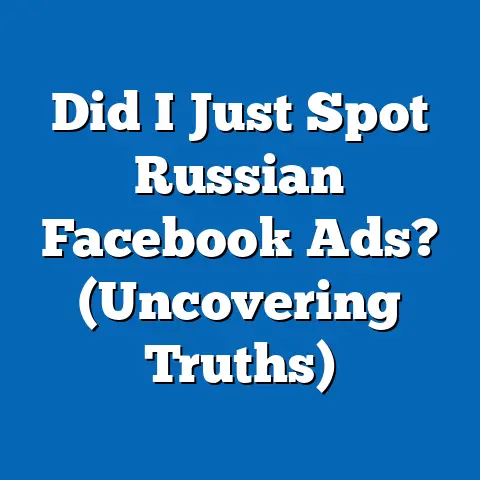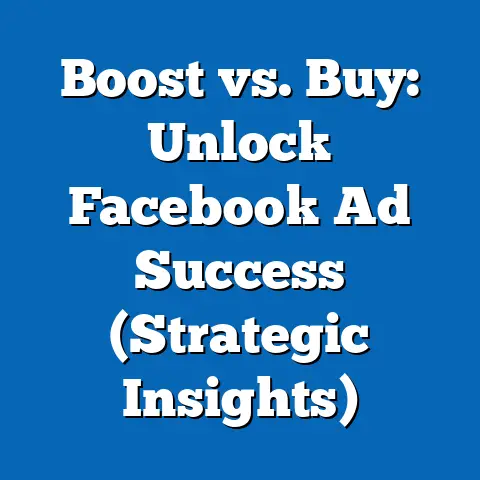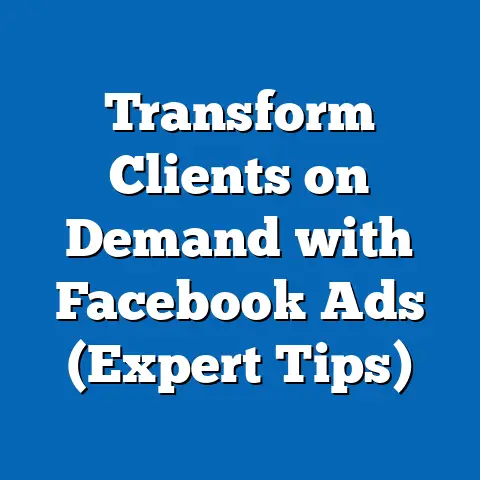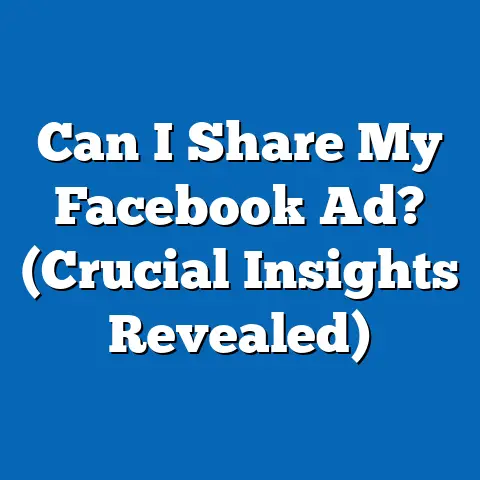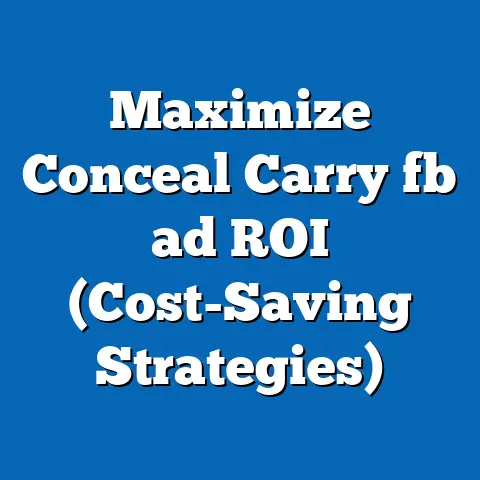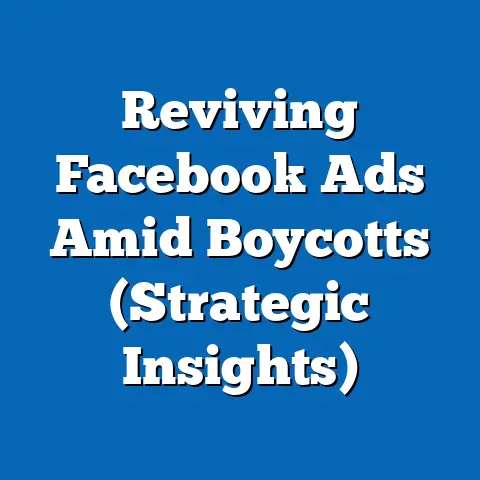Maximize Ad Impressions on Facebook (Unlock Powerful Insights)
Have you ever wondered why some flavors linger on your palate, creating a memorable experience, while others fade away almost immediately? In the world of Facebook advertising, the same principle applies. Your ad impressions are like those flavors, and to truly succeed, you need to create an impression that sticks, leaving a lasting impact on your target audience.
In this article, I’m going to take you on a journey to understand the ins and outs of Facebook ad impressions. I’ll delve into the psychology behind why impressions matter, how to analyze your target audience to maximize those impressions, and the secrets to crafting compelling ad content that grabs attention. We’ll also explore the power of Facebook’s ad formats and features, the importance of timing and frequency, and how to continuously monitor and optimize your campaigns for maximum impact. My goal is to equip you with the knowledge and tools you need to create Facebook ad campaigns that not only reach your target audience but also leave a lasting impression.
Understanding Facebook Ad Impressions
Let’s start with the basics: What exactly are ad impressions? Simply put, an ad impression is counted each time your ad is displayed to a user on Facebook. It doesn’t matter if they click on it, engage with it, or even notice it – if it’s shown, it’s an impression.
However, the true value of ad impressions lies in their ability to build brand awareness and familiarity. Think of it like this: the more often someone sees your brand, the more likely they are to remember it when they’re ready to make a purchase. This is why maximizing your ad impressions is so crucial for long-term success.
Impressions vs. Reach: What’s the Difference?
It’s easy to confuse impressions with reach, but they’re two distinct metrics. Reach refers to the number of unique individuals who saw your ad, while impressions refer to the total number of times your ad was displayed.
For example, if your ad reached 1,000 people and generated 3,000 impressions, that means each person saw your ad an average of three times.
Understanding the difference between reach and impressions is crucial because it helps you gauge the effectiveness of your campaign. A high reach with low impressions might indicate that your targeting is too broad, while a low reach with high impressions could mean your ad is being shown to the same people too frequently.
Key Metrics to Assess Ad Impression Effectiveness
While the raw number of impressions is important, it’s even more important to understand how those impressions are translating into results. Here are a few key metrics to keep an eye on:
- Cost Per Thousand Impressions (CPM): This metric tells you how much you’re paying for 1,000 impressions. A lower CPM means you’re getting more bang for your buck.
- Click-Through Rate (CTR): This measures the percentage of people who saw your ad and clicked on it. A higher CTR indicates that your ad is relevant and engaging to your target audience.
- Relevance Score: Facebook assigns a relevance score to your ads based on how well they resonate with your target audience. A higher score can lead to lower costs and better ad delivery.
- Frequency: As mentioned earlier, frequency is the average number of times a person saw your ad. Monitoring frequency is essential to prevent ad fatigue.
Takeaway: Ad impressions are the foundation of your Facebook advertising campaigns. Understanding the difference between reach and impressions, and monitoring key metrics like CPM, CTR, relevance score, and frequency, are essential for maximizing your ad’s effectiveness.
The Psychology Behind Ad Impressions
Now that we’ve covered the basics of ad impressions, let’s dive into the fascinating world of psychology and explore why repeated exposure to ads can influence consumer behavior.
The Mere Exposure Effect
One of the most well-known psychological principles at play here is the mere exposure effect, which suggests that people tend to develop a preference for things simply because they are familiar with them. In other words, the more often someone sees your ad, the more likely they are to develop a positive association with your brand.
This effect is particularly powerful when people are making decisions quickly or without much conscious thought. For example, if someone is scrolling through their Facebook feed and sees an ad for your product, they might not immediately click on it. However, the next time they’re in the market for that product, your brand will be top of mind, thanks to the repeated exposure.
Building Brand Familiarity
Ad impressions play a crucial role in building brand familiarity, which is the degree to which consumers recognize and remember your brand. The more familiar people are with your brand, the more likely they are to trust it and consider it when making a purchase.
Think about some of the most successful brands in the world, like Coca-Cola or Nike. They’ve spent decades building brand familiarity through consistent advertising and marketing efforts. Even if you’re not in the market for a soda or a new pair of shoes, you still recognize these brands instantly, thanks to the countless impressions they’ve generated over the years.
Case Studies: The Power of Impressions
Let’s take a look at a couple of real-world examples of campaigns that have leveraged the power of impressions effectively:
- Dollar Shave Club: This company disrupted the shaving industry with its clever and humorous video ads, which quickly went viral. By generating millions of impressions across Facebook and other platforms, they were able to build brand awareness and acquire a large customer base in a short amount of time.
- Old Spice: The “The Man Your Man Could Smell Like” campaign transformed Old Spice from a brand associated with older men to a hip and trendy brand that appealed to a younger audience. The campaign’s success was largely due to its widespread reach and high number of impressions, which helped it break through the clutter and capture people’s attention.
Takeaway: Understanding the psychology behind ad impressions, particularly the mere exposure effect and the importance of building brand familiarity, is crucial for creating effective Facebook advertising campaigns. By focusing on generating consistent and high-quality impressions, you can increase brand awareness, build trust, and ultimately drive sales.
Analyzing Target Audience to Maximize Impressions
You can’t just show your ads to anyone and expect them to resonate. To maximize your ad impressions, you need to understand your target audience inside and out. This means analyzing their demographics, interests, behaviors, and online habits.
Audience Segmentation and Targeting
Audience segmentation is the process of dividing your target audience into smaller groups based on shared characteristics. This allows you to tailor your ads to specific segments, increasing their relevance and engagement.
Facebook offers a wide range of targeting options, including:
- Demographics: Age, gender, location, education, relationship status, etc.
- Interests: Hobbies, passions, activities, etc.
- Behaviors: Purchase history, online activity, device usage, etc.
- Connections: People who like your page, friends of people who like your page, etc.
By combining these targeting options, you can create highly specific audience segments that are more likely to respond to your ads.
Tools and Methods for Analyzing Your Audience
Facebook provides a variety of tools to help you analyze your target audience:
- Facebook Audience Insights: This tool provides valuable data about your target audience, including their demographics, interests, behaviors, and page likes.
- Facebook Pixel: This code snippet tracks the actions people take on your website after clicking on your ad. This data can be used to optimize your campaigns and create retargeting audiences.
- Google Analytics: By integrating Google Analytics with your Facebook ads, you can track the performance of your campaigns and gain insights into your audience’s behavior on your website.
Creating Custom and Lookalike Audiences
In addition to Facebook’s standard targeting options, you can also create custom and lookalike audiences.
- Custom Audiences: These audiences are created by uploading your own customer data, such as email addresses or phone numbers. This allows you to target existing customers or people who have interacted with your business in the past.
- Lookalike Audiences: These audiences are created by identifying people who share similar characteristics with your existing customers. This is a great way to expand your reach and find new customers who are likely to be interested in your products or services.
Takeaway: Analyzing your target audience is essential for maximizing your ad impressions. By segmenting your audience, using Facebook’s targeting options, and creating custom and lookalike audiences, you can ensure that your ads are shown to the right people at the right time.
Crafting Compelling Ad Content
Now that you know how to target your audience, let’s talk about creating ad content that grabs their attention and encourages them to engage.
Visual Appeal
In the fast-paced world of social media, you have just a few seconds to capture someone’s attention. That’s why it’s crucial to create ads that are visually appealing.
Here are a few tips for creating visually appealing ads:
- Use high-quality images and videos: Avoid blurry or pixelated images.
- Choose images that are relevant to your target audience: Consider their interests and preferences.
- Use bright and vibrant colors: Colors can evoke emotions and attract attention.
- Keep it simple: Avoid clutter and focus on a clear message.
Resonating with Your Audience
Your ad content should not only be visually appealing but also resonate with your target audience. This means understanding their needs, wants, and pain points.
Here are a few tips for creating ad content that resonates with your audience:
- Speak their language: Use the same words and phrases that they use.
- Address their pain points: Show them that you understand their challenges.
- Offer a solution: Explain how your product or service can help them solve their problems.
- Tell a story: Stories are a powerful way to connect with your audience on an emotional level.
The Importance of Ad Copy and Call-to-Action
Your ad copy and call-to-action are just as important as your visuals. Your ad copy should be concise, compelling, and persuasive. It should clearly explain the benefits of your product or service and encourage people to take action.
Your call-to-action (CTA) is the final push that encourages people to click on your ad. Use strong action verbs, such as “Shop Now,” “Learn More,” or “Sign Up.”
A/B Testing for Optimization
A/B testing is the process of comparing two versions of an ad to see which one performs better. This is a great way to optimize your ad content for better impressions.
Here are a few things you can A/B test:
- Headlines: Try different headlines to see which one attracts more attention.
- Images: Test different images to see which one resonates more with your audience.
- Ad copy: Experiment with different ad copy to see which one is more persuasive.
- Call-to-action: Try different CTAs to see which one generates more clicks.
Takeaway: Crafting compelling ad content is essential for maximizing your ad impressions. By focusing on visual appeal, resonating with your audience, and optimizing your ad copy and call-to-action through A/B testing, you can create ads that capture attention and drive results.
Leveraging Facebook Ad Formats and Features
Facebook offers a variety of ad formats and features that can help you maximize your ad impressions. Let’s explore some of the most effective options.
Carousel Ads
Carousel ads allow you to showcase multiple images or videos within a single ad. This is a great way to highlight different products, features, or benefits.
Video Ads
Video ads are highly engaging and can capture attention more effectively than static images. They’re perfect for telling stories, demonstrating products, or sharing testimonials.
Slideshow Ads
Slideshow ads are a cost-effective way to create visually appealing ads using a series of images. They’re easy to create and can be used to tell a story or showcase different aspects of your brand.
Dynamic Ads
Dynamic ads automatically show the most relevant products to each individual user based on their browsing history and interests. This is a great way to personalize your ads and increase their effectiveness.
Collection Ads
Collection ads combine images and videos to create a visually immersive shopping experience. They’re perfect for showcasing a range of products and encouraging users to browse your online store.
Utilizing Facebook’s Ad Placement Options
Facebook offers a variety of ad placement options, including:
- Facebook Feed: This is the most common ad placement, where your ads appear in users’ news feeds.
- Instagram Feed: Your ads can also appear in users’ Instagram feeds.
- Facebook Stories: Stories are a popular way to share short-form video content.
- Instagram Stories: Similar to Facebook Stories, your ads can also appear in Instagram Stories.
- Audience Network: This allows you to extend your reach beyond Facebook and Instagram by showing your ads on other websites and apps.
Takeaway: Facebook offers a wide range of ad formats and features that can help you maximize your ad impressions. By experimenting with different options and utilizing Facebook’s ad placement options, you can create campaigns that are highly engaging and effective.
Timing and Frequency of Ads
The timing and frequency of your ads can have a significant impact on their performance.
Best Times to Post Ads
The best times to post ads depend on your target audience and their online habits. Generally, the best times to post are during peak usage hours, such as evenings and weekends.
Facebook provides data on when your target audience is most active, which can help you determine the optimal times to schedule your ads.
Managing Ad Frequency
As mentioned earlier, ad frequency is the average number of times a person sees your ad. While repeated exposure can be beneficial, too much exposure can lead to ad fatigue, which can negatively impact your campaign’s performance.
To prevent ad fatigue, it’s important to monitor your ad frequency and adjust your targeting or ad content accordingly. You can also use frequency capping, which limits the number of times a person sees your ad within a given timeframe.
Scheduling Ads for Consistency
Scheduling your ads can help you maintain a consistent presence without overwhelming your audience. This allows you to reach your target audience at the right time and frequency, maximizing your ad impressions.
Takeaway: Timing and frequency are crucial factors to consider when running Facebook ad campaigns. By understanding your audience’s online habits, managing ad frequency, and scheduling your ads effectively, you can maximize your ad impressions and prevent ad fatigue.
Continuous Monitoring and Optimization
The final step in maximizing your ad impressions is continuous monitoring and optimization.
Tracking Ad Performance Metrics
It’s essential to monitor your ad performance metrics regularly to understand what’s working and what’s not. This includes tracking impressions, reach, CPM, CTR, relevance score, and frequency.
Using Facebook Analytics and Ads Manager
Facebook provides a variety of tools for tracking ad performance, including Facebook Analytics and Ads Manager. These tools allow you to monitor your key metrics, analyze your audience data, and identify areas for improvement.
Pivoting Strategies Based on Data-Driven Insights
Based on your data-driven insights, you may need to pivot your strategies to continually maximize your ad impressions. This could involve adjusting your targeting, ad content, ad formats, or ad placement options.
Takeaway: Continuous monitoring and optimization are essential for maximizing your ad impressions. By tracking your performance metrics, using Facebook Analytics and Ads Manager, and pivoting your strategies based on data-driven insights, you can ensure that your campaigns are always performing at their best.
Conclusion
Maximizing ad impressions on Facebook is a complex but rewarding process. By understanding the fundamentals of ad impressions, delving into the psychology behind why they matter, analyzing your target audience, crafting compelling ad content, leveraging Facebook’s ad formats and features, optimizing your timing and frequency, and continuously monitoring and optimizing your campaigns, you can create Facebook ad campaigns that not only reach your target audience but also leave a lasting impression.
Remember, success in Facebook advertising is not just about reaching the most people, but about creating a meaningful and memorable experience that resonates with your target audience and drives results. So, go out there, experiment with different strategies, and create Facebook ad campaigns that leave a lasting impression!
Call to Action
I’d love to hear about your experiences and strategies for maximizing ad impressions on Facebook. Share your thoughts in the comments below! What has worked for you? What challenges have you faced? Let’s learn from each other and create even more effective Facebook ad campaigns together.

